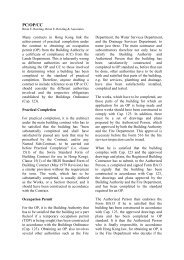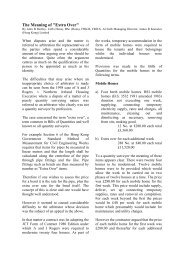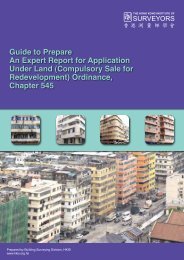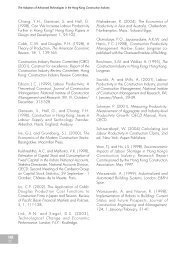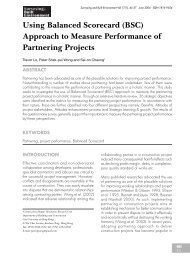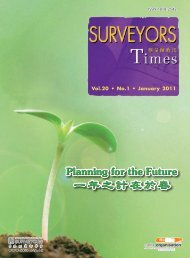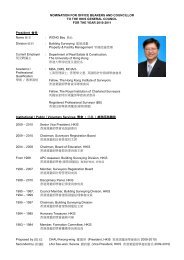Surveying & Built Environment Vol. 22 Issue 1 (December 2012)
Surveying & Built Environment Vol. 22 Issue 1 (December 2012)
Surveying & Built Environment Vol. 22 Issue 1 (December 2012)
Create successful ePaper yourself
Turn your PDF publications into a flip-book with our unique Google optimized e-Paper software.
ModEllING GASEouS<br />
EMISSIoNS duRING THE<br />
BuIldING lIfE CYClE<br />
According to Intergovernmental Panel<br />
on Climate Change (Intergovernmental<br />
Panel on Climate Change, 2006),<br />
the basic formula for the estimation<br />
of emissions from a single pollution<br />
source is in Equation (1).<br />
Emissions = AD x EF (1)<br />
where AD is the activity quantity; and<br />
EF the coefficient which quantifies the<br />
emissions or emission removals per unit<br />
of activity.<br />
Different equipment for measuring<br />
the quantity of the gaseous emissions<br />
produced will require calibration at least<br />
every six months, or according to local<br />
standards if these are more frequent, to<br />
ensure accurate data is collected for any<br />
calculation.<br />
Manufacture of building materials<br />
In building materials manufacture, if<br />
the quantity data of each material used<br />
in a building is provided, then by using<br />
the emission factor, emissions can be<br />
calculated through Equation (2).<br />
Emission 1i = ∑Q j x EF ij<br />
<strong>Surveying</strong> and <strong>Built</strong> <strong>Environment</strong> <strong>Vol</strong> <strong>22</strong>, 61-73 Nov <strong>2012</strong> ISSN 1816-9554<br />
(2)<br />
where i ( i = 1, …, 8 ) is a particular<br />
type of emission, such as CO 2, CH 4,<br />
N 2O, SO 2, CO, NO X, NMVOC and<br />
particulates generated by the production<br />
of each material; j ( j = 1, …, 7 ) is a<br />
particular type of material used, such as<br />
cement, steel, aluminium, glass, sand<br />
and timber; Q j is the sum of energy for<br />
producing any material j (kg/kWh); EF ij<br />
is the emission factor of any emission<br />
i generated by producing a unit of<br />
material j (kg/kWh); Emissions ij is<br />
therefore the total quantity of emission<br />
i in material manufacture (g), and<br />
“1” denotes the material manufacture<br />
element. The quantity of each type of<br />
material is calculated in kg.<br />
Transportation of building materials<br />
In transporting building materials, the<br />
following four types of transport are<br />
considered: road transport, railway<br />
transport, aviation transport, and sea<br />
transport. If the distance data and<br />
fuel data are provided, transportation<br />
emissions can be calculated through<br />
Equation (3).<br />
Emission 2i = D x FR x EF ij<br />
(3)<br />
where i ( i = 1, …, 8 ) is one of<br />
the emissions, such as CO 2, CH 4,<br />
N 2O, SO 2, CO, NO X, NMVOC and<br />
particulates; Emissions ij is the quantity<br />
of emission i in transportation (g); D<br />
the total transport distance (km); FR<br />
the fuel consumption rate of the means<br />
of transport (kWh/km); D x FR the<br />
amount of fuel combusted (litre or<br />
kWh); and EF ij the emission factor of<br />
emission i generated from fuel j type<br />
of combustion (kg/kWh). The fuel<br />
consumption data is calculated by fuel<br />
type, by conveyance category and by<br />
transport mode.<br />
Construction<br />
In building construction, emissions<br />
are mainly generated by using electric<br />
power and burning fuel. The data for<br />
electricity and fuel used in this period<br />
are needed to calculate emissions by<br />
using Equation (2) and replacing j ( j<br />
= 1, …, n ) as one of the fuel types and<br />
Q j as the amount of the fuel j burned or<br />
electricity used (kWh).<br />
SBE<br />
67




